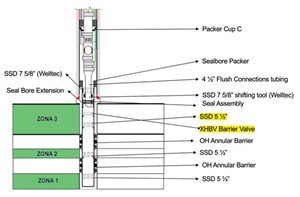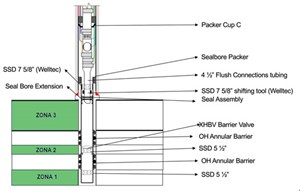Innovative approach optimizes the completion cycle
The design and application of innovative well architecture is required to overcome some of the most adverse pre-salt cluster environments encountered in one of the largest deep-water oil fields in the world. An operator in Brazil’s Santos basin is overcoming technological challenges presented by the pre-salt formation by investing heavily in cutting edge technology, demanding higher quality and exceeding international standards. Technical performance optimization is realized by leveraging product reliability and services provided by their global network of suppliers.
Brazil’s Santos basin pre-salt zone. The pre-salt is a set of carbonate rocks on the Brazilian coastline in the Santos basin, with high potential for oil and gas production. During a past geological event, a thick and widespread layer of salt was deposited over these formations, which are up to 2,000 m in thickness and approximately 7,000 m below sea level. Since the beginning of the pre-salt campaign, for the first time, oil and natural gas production in the pre-salt exceeded 70% of the total national production, reaching almost 2.5 MMboed. Some wells in the pre-salt cluster can produce more than 55,000 bopd, with potential to produce more than 70,000 bopd.The operator identified an opportunity to streamline its completion plan. The additional well stimulation vessel resources and rig time required to stimulate the uppermost production zone were costly. Additionally, the operator wanted to optimize operations resources and minimize exposure of the well during the lower completion phase, greatly reducing risk.
TOOL DEVELOPMENT
Superior Completion Services (Superior) was invited by the operator to participate in a global tender encompassing numerous lower completion equipment and with a challenging well architecture. The objective was timely delivery of technically sound, high-performance, economical and reliable downhole completion tools that had an established history of worldwide success. Superior participated in several bids as a potential supplier of lower completions for sand control formations and a pre-salt cluster area, and was ultimately awarded the job. The service company was able to complete product development and production in record time, exceeding the operator’s technical specifications and quality requirements.
Along with the operator’s engineering team, the completion architecture was scrutinized with the intent to perform stimulation treatment of multiple zones in a single trip, using a PACI2+1 system. This system was capable of a one-trip lower completion and provided selective stimulation of all three zones in a single, lower completion installation. Subsequently, rig time and NPT of the second vessel were thereby eliminated. Well stimulation vessel resources were optimized and utilized effectively to stimulate and treat all three zones on a single vessel trip.
A novel, yet extremely simple, new optimized stimulation method/operation was developed by the operator’s engineering team and Superior, which involved adding a third sliding sleeve for stimulation, only at the upper zone. The operator designed the well structure, and Superior modified and improved upon it, without introducing a completely new application methodology. As a result, it was the fastest installation ever performed by the operator. Today, the service company is one of the main providers of lower completion technologies to this operator.
Methodology overview. The original well configuration consisted of completing two zones, wherein the lower zone was stimulated first, Fig. 1. The intelligent completion was installed, and then the upper zone was stimulated via the intelligent completion system. This resulted in requiring the well stimulation vessel to be on location twice: first during the stimulation of the lower completion, and then after the installation of the upper intelligent completion.
The same process was to apply to the proposed three-zone completion, Fig. 2. Initially, the stimulation operation was designed to be performed in two steps: stimulation of lower and middle zones during installation of the lower completion; and stimulation of the third zone, after installation of the intelligent upper completion. The second step, as before, would have required having all stimulation resources, vessel and structures available to complete the stimulation of the third zone. With resourceful placement of Superior’s large-bore MSV, and by utilizing a customized service string design, all zones were, instead, treated in a single trip during the installation of the lower completion. This not only saved the operator potentially several days of costly rig time required to stimulate the uppermost production zone, it also eliminated unnecessary, additional, stimulation vessel resources.

From an HSEQ perspective, any procedure or equipment performed or introduced downhole adds to the level of complexity and risk of something going wrong. The company’s operational process improvement reduced HSEQ risks by minimizing contact with the well. After the multi-zone treatment, the service string was pulled from where the lower completion was installed, several thousand feet deep, to the surface, and the upper completion was run and installed. The subsea tree (XMT) was fitted, and the rig was moved out of the location. Finally, the production facility took over the responsibility of triggering the Reclosable Hydraulic Barrier Valve (X-HBV) remotely and putting the well into production.
New-concept stimulation-only sliding sleeve. The new concept circumvented the necessity of stimulating the third zone through the upper intelligent completion, minimizing rig time and stimulation vessel resources by presenting a simple and low-cost solution: a third stimulation-only sliding sleeve. After stimulating the zones and isolating the well by closing the X-HBV, the operator was able to temporarily abandon the well and continue its completion campaign sequence in batches on other wells, optimizing several OPEX and CAPEX resources, and improving the entire logistics process.
Successful use of the reclosable hydraulic barrier valve. An X-HBV is a sought-after device used to protect the wellbore by creating a barrier to the formation and enabling various important activities to be carried out during a subsea completion. However, despite the highly advanced and extremely capable nature of such products, they have long been plagued with unreliability, which often requires costly intervention to initiate well production when they fail to open remotely.
A comparable class of product was hitherto absent from Superior’s product arsenal for some time. But, given the company’s proven track record with completion tools and its history of achieving several industry firsts, the company set about developing a unique and intuitive product with reliable, field-proven mechanisms while being economical for the global clientele. The technical requirements were considered in detail, and a vision was set in motion to design, develop, qualify and commercialize this product. Work began in mid-2018, with the first installation and successful remote opening globally taking place in October 2019. This represented a new record time in developing and commercializing a barrier valve-type product. Since then, there have been double-digit installations in subsea wells for the operator, including this project. To date, this product, a relative newcomer to a very competitive and well-established global market, has enjoyed a 100% success rate. By using Superior’s X-HBV in multi-zone projects, the operator has been able to reliably function these valves remotely, consistently and accurately, at the cycle count it is pinned for.
Results. The operational process improvement provided by the operator’s engineering team and Superior drastically improved the capability of the overall installation. As a result, the well, which utilized the new well completion configuration, now holds the record as the fastest well ever completed by the operator. The benefits for the operator included logistical optimization, reduced HSEQ exposure, improved installation reliability and minimization of well exposure. Significant cost-savings were acknowledged from reduced rig time, advanced oil recovery and the early initiation of production.
The sliding sleeve and the X-HBV were products designed and developed by Superior to meet or exceed industry standards (API19AC). They were instrumental in delivering the process improvement package. Superior was able to qualify the higher-pressure variant of the X-HBV (API19V -V1, gas-tight) in record time to meet unique requirements, and to be made available in this region, on time, for the project. Overall, the project was planned well by the operator and surpassed its original objective.
Lessons learned. No matter how entrenched a technology is with a major operator, it is important to recognize that there are always alternatives. Some of them are just as qualified, reliable, economical as the original technology, and often they are a far better fit for an application, as was the case for the simple addition of a sliding sleeve and X-HBV in this example. By exceeding the operator’s requirements and deploying a resourceful utilization of a simple, widely available device in the completion string, a significant amount of expenditure was eliminated, with production and commissioning delivered far earlier than anticipated.
The innovative approach to devising the one-trip solution shaved days and weeks off the work schedule. With in-depth knowledge of the completion process, the invaluable experience to apply lessons learned, and an unconventional approach to solving problems, the engineering team and Superior worked together to realize significant financial gains in this project for the operator.
- Using data to create new completion efficiencies (February 2024)
- Digital completions platform provides complete operations visibility to enhance efficiency, collaboration (December 2023)
- Delivering a full range of innovative well completion technologies (September 2023)
- Downhole tool integrity maximizes completion efficiency and ultimate recovery (July 2023)
- Enhancing stimulation efficiency in a fractured open-hole carbonate reservoir by diversion design using advanced modelling techniques (May 2023)
- Automated completion surface system: The path to fracturing 24/7 (May 2023)
- Applying ultra-deep LWD resistivity technology successfully in a SAGD operation (May 2019)
- Adoption of wireless intelligent completions advances (May 2019)
- Majors double down as takeaway crunch eases (April 2019)
- What’s new in well logging and formation evaluation (April 2019)
- Qualification of a 20,000-psi subsea BOP: A collaborative approach (February 2019)
- ConocoPhillips’ Greg Leveille sees rapid trajectory of technical advancement continuing (February 2019)



